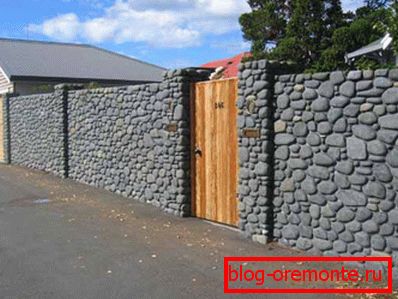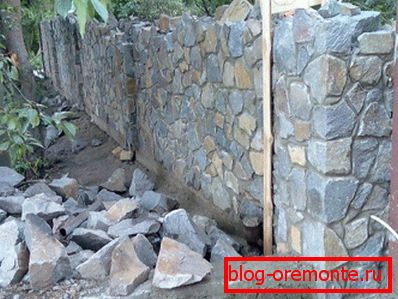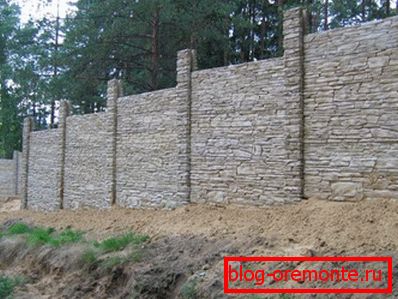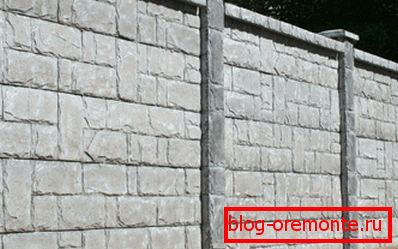Stone fence is a great way to ensure the reliability of the
Of course, there are no trifles in the construction and equipping of your country house. Everything is very important and interconnected. Therefore, it would be time, and most importantly - experience and skill, I would like to do everything myself, or at least take an active part in everything. In all, of course, will not succeed, but you can try to build a stone fence with your own hands.
Moreover, the technology is simple, the material is at hand, and the work is extremely important, because your fence will be the first to meet all your guests. Already by what kind of fence, there can be an impression about the owner of the house behind him.

The appearance of a stone fence, of course, depends largely on the type of stone chosen. The right choice guarantees not only a durable and reliable fence, but also its remarkable aesthetic qualities.
They say - meet on clothes. Make the fence clothes of your country house

A wild stone fence with your own hands, but with caps on pillars and canopies over the spans, and you have a wonderful structure at your disposal that will serve for a long time
Fortunately, the material is very flexible and diverse.
The following types of stone are at your disposal:
- Natural, natural. This stone was used for building fences from ancient times, it has not lost its popularity today. When choosing such a stone, it is only important to think about its availability in the future. As for the types of natural stone, the choice is quite diverse:
- First of all, of course, granite. It has a very high strength, a large variety of sizes, but, most likely, you will not be able to do without a hammer or a sledgehammer when working with granite - often you have to break granite stones to fit the size.
- Dolomite. Dolomite is the result of blasting in the mountains. The resulting rock is then processed, often with the use of grinding machines, hence the very attractive appearance of this stone.
- Shingle. A very common material, perfectly amenable to chopping. For a long time, the cobblestone was used for the construction of our roads, and thus it has already proved its reliability and resistance to external influences. When, recently, our road services decided to replace cobbled roads with more comfortable asphalt ones, and a large amount of this stone appeared, which was used for fences.
- Limestone. An attractive breed of stone for its accessibility. But, unfortunately, such limestones before application must be treated with special compounds to strengthen the structure. Otherwise, do not avoid too fast destruction under the influence of adverse weather conditions.
- Sandstone. Using sandstone is very convenient - it can be easily processed. But this is at the same time its disadvantage when used as the main material for the intake, it is also necessary to do without preliminary processing.
- Pebble. Pebble привлекает своей предельной гибкостью, ведь её размеров очень много. В первую очередь используется для заборов крупная галька. Но в любом случае сооружение забора из гальки – очень трудоёмкий процесс.
- Artificial. A very popular material that imitates natural - granite, dolomite, cobble. It is not inferior to their "tesok" for strength, artificial stone is much superior to them in appearance and usability, because you can choose a material of almost any size. A fence made of artificial stone always looks great, and you yourself can control its appearance as you build. Such a fence does not require the construction of a strong foundation and additional processing.
- French stone. As a matter of fact, there is no such stone as such - it is just an artificial cinder block with dimensions of 120 x 200 x 400 mm. But thanks to its external attractiveness, lightness, durability and reliability, the “Frenchman” won his deserved place in the construction of fences.

Fences made of stone with their own hands for leveling and strengthening can be supported by a completely “civilized” brick, which always looks very original.
Helpful advice! When working with a natural stone, it is impossible to do without adjusting its size - you always have to keep a powerful hammer or even a sledge hammer under your hands. When doing the chopping of a stone, be extremely careful and follow safety precautions. First, be sure to use special glasses to protect your eyes. It should be not just sunglasses from the sun - the ideal option would be something like ski goggles, closed on all sides. Secondly, use sturdy hard gloves. Thirdly, perform all the work on adjusting the size of stones alone, remove all outsiders from the place of work. Outsiders are often a source of trouble - flying off the splinters will not harm you, but, unfortunately, they easily find those who are curious around you, you cannot avoid serious injuries.
Operating procedure
The construction of a stone fence consists of the following steps:
- It is first necessary to conduct a very accurate marking of the fence - the location of the pillars, the size of the spans. This will accurately determine the need for the material.
- Next, proceed to the preparation of the foundation. The nature of the foundation depends largely on the selected stone, the nature of the fence and its height. But the total geometric dimensions may be as follows:
- the size of the ditch for the foundation of the span width - 20-25 cm;
- the depth of the ditch under the span - 40-60 cm;
- the depth of the pit under the pillars between the spans, if they are to be installed, and, as a rule, the pillars are put up to 1.5 meters; here it is necessary to take into account that the depth of soil freezing is more than 1 meter;
- pillars are usually made square, so the size of the pit for them along the length-width is 40 to 40 cm.
- Then the prepared trenches are poured with concrete to the ground level.

So, layer by layer, constantly controlling the verticality of the whole structure and having the prepared stone under your hands.
- The pouring of concrete is accompanied by immersion into a still liquid mass of special metal frames under the fence posts — grillages, to a depth of 50 cm and thickness up to 12 mm.
- It is necessary to wait at least 2-3 days for the concrete to solidify the foundation and begin already laying the fence. The whole process consists of sequential laying of stones in horizontal layers.
- The only problem is that you need patience. You will not be able to build one span in height in one day - laying one horizontal level requires waiting at least 2-3 days before you can proceed to the next.
- Be sure to set the controlling "beacons" vertically and horizontally, indicating the accuracy of the location of the fence. Constantly coordinate your actions with the help of a level. The main qualitative characteristic of the fence is its perfectly flat position.

Natural stone fences specially cut and processed, and even with decorative elements, the size of the stone itself is not at all important to you. Here the bet is made on small horizontal bars.
Helpful advice! Preparation of the foundation of the fence is a very important stage. You must provide very reliable concrete laying. It can not do without his careful tamping. Use for this purpose special vibrating devices, machines for concrete tamping. In the future, the quality of all the work will depend on the quality of the concrete masonry in the foundation of the fence.
Ready poles
Perhaps for the construction of fence posts you decided to use ready-made structures - special posts for stone fences can greatly simplify all the work. In this case, the pillars are installed directly into the poured concrete on a pre-installed brick base.
Very important in this situation will be constant monitoring of the ideal verticality of the frame. The use of such pillars significantly speeds up all the work, but it is clear that further finishing of the pillars of the fence with a stone is sure to follow. This must be borne in mind when choosing a stone - it must be suitable not only for laying in the spans, but also for finishing the pillars.

Post installation
How to make the decoration of the pillars depends largely on the nature of the already finished pillar design and your design abilities. Very often in this situation they deviate from the use of the main stone “for spans” and use red or white brick or a completely different kind of stone.

If the stone fence, it is not necessarily a strong foundation and cement of the 200th mark - skillful design solutions will help you save materials and time
Helpful advice! When building a stone fence, be sure to protect the base from the weather. To do this, around the perimeter of the fence, both spans and pillars, both outside and inside: carefully create a kind of buffer zone from rammed concrete masonry not less than 15 cm wide; concrete masonry must necessarily have a slope away from the fence; It will be very useful to continue this buffer zone on the ground, slightly deepening it and filling it with small pebbles. Carefully walk around the perimeter of the entire fence and eliminate all places of possible accumulation of water.

The task of how to build a stone fence is complicated if the installation trajectory “jumps” in height. Then you can not do without significant soil work, accurate calculation and pre-installation of pillars.
Making the upper surfaces of the spans and pillars
To protect against the effects of precipitation, and to a considerable extent, and for a better appearance of the fence, it is advisable to take care of placing all possible tips and parapets on the upper surfaces of the spans and pillars.
The use of such elements should be thought out in advance. Determine their availability, possible options, and most importantly sizes. These dimensions will determine the thickness of the span of your fence and the horizontal dimensions of the pillar.

Thanks to the ideal dimensions of this material, the laying of a French stone fence often turns into a fascinating path to perfection, which begins to be felt from the first lower levels.
For poles, tips usually have a cone shape with dimensions:
- base 40 by 40 cm, or
- 50 to 50 cm;
- height - from 10 to 30 cm.

In what capacity will you use the pillars for the fence of stone depends largely on your design ideas. A hollow pillar does not at all mean less reliable, but it allows additional communication to take place inside.
Decorative plates for the upper surfaces of the spans are usually of dimensions (width - length):
- 20 to 30 cm;
- 30 to 40 cm;
- or 30 to 50 cm.
Be sure to choose such decorative plates, too, with a beveled upper surface, this will prevent the accumulation of water on the upper surface.
Before making a decision
This is the perennial problem for beginners in the construction of fences - the provision of verticality.
The solution to this problem can be twofold:
- or you will be smart and provide yourself with permanent and reliable controls in the process;
- or you will be even more clever and invite to perform all the leading work of an experienced master.
Check out all the videos in this article, view all photo materials. Listen to the opinion of the Master and be his diligent student. Let any of his instructions on the work performed will be your law.

Fences made of artificial stone - by nature, cement - sometimes amaze with a variety of design possibilities
Then the fence will turn out to be spectacular. After all, the price of an unsuccessfully erected fence is quite high. It is not even expressed in the specific numbers of your finances, it is often expressed in the opinion of you on the part of those who are outside your fence.